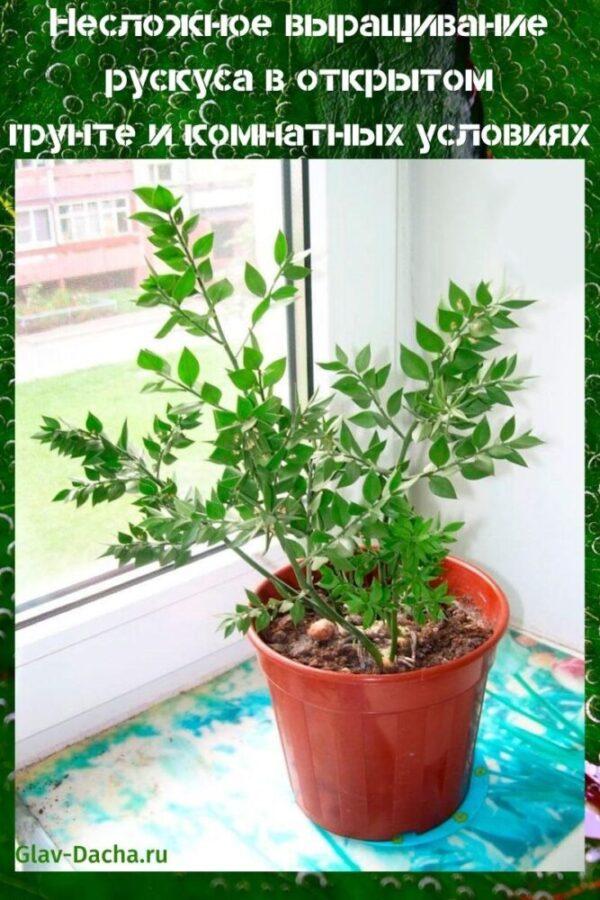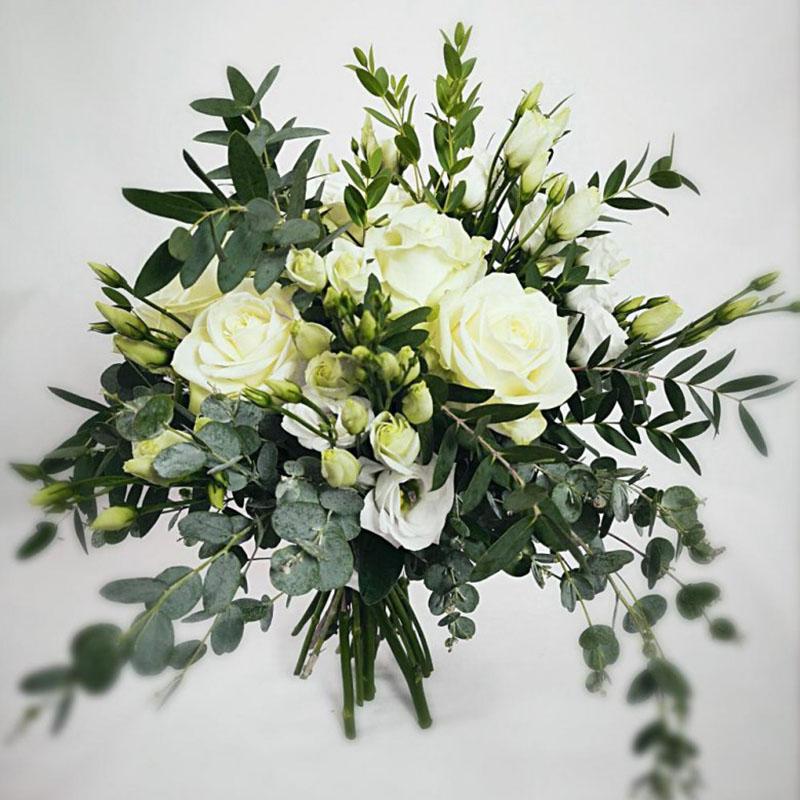Easy cultivation of ruscus in the open field and indoor conditions
 A branchy evergreen plant can leave few people indifferent. Connoisseurs of exotic indoor culture recommend planting Ruscus not only in the open field on the site, but also in indoor conditions. Cultivation of Ruscus does not require much effort and knowledge.
A branchy evergreen plant can leave few people indifferent. Connoisseurs of exotic indoor culture recommend planting Ruscus not only in the open field on the site, but also in indoor conditions. Cultivation of Ruscus does not require much effort and knowledge.
On average, the height of a branchy shrub is 70 cm. The plant feeds on the surface rhizome. Branched shoots are covered with dark green bark. There are small needle-shaped green leaves. The plant can develop a powerful root system underground. Shoots form white flowers. Fleshy bright red berries with a diameter of up to 2 cm appear from them. The fruits have several seeds inside. Pollination in the natural environment occurs at the expense of insects. At home, this is possible by transferring pollen from a plant with staminate flowers.
Practical use

 Many centuries ago, people used the herbaceous perennial to decorate gardens and squares. A low plant harmoniously fits into the design curbs and hedges. The decor looks relevant at any time of the year. Thin shoots of the plant, reminiscent of needles with red berries, are suitable for the role of a Christmas mascot. Florists love to use cut branches with berries to create interesting bouquets. The flower is suitable for landscaping public places such as cafes or restaurants.
Many centuries ago, people used the herbaceous perennial to decorate gardens and squares. A low plant harmoniously fits into the design curbs and hedges. The decor looks relevant at any time of the year. Thin shoots of the plant, reminiscent of needles with red berries, are suitable for the role of a Christmas mascot. Florists love to use cut branches with berries to create interesting bouquets. The flower is suitable for landscaping public places such as cafes or restaurants.
 Ruscus leaves with a scattering of scarlet berries are used in medicine. The plant fights headaches and relieves convulsions. The flower normalizes blood pressure, reduces swelling and strengthens the cardiovascular system. It is used to treat varicose veins and hemorrhoids.
Ruscus leaves with a scattering of scarlet berries are used in medicine. The plant fights headaches and relieves convulsions. The flower normalizes blood pressure, reduces swelling and strengthens the cardiovascular system. It is used to treat varicose veins and hemorrhoids.
Butchery has the following properties:
- anti-inflammatory;
- vasodilators;
- laxatives;
- antimicrobial;
- strengthening.
Berries are used as a substitute for coffee.
In its pure form, the Ruscus fruit has a low nutritional value, being considered poisonous.
Types of ruscus for home cultivation
The plant is not common on the planet. Most often Ruscus is grown in Africa, Europe and Crimea.
Butcher is presented in several forms:
- Butcher's broom under suitable conditions is tall. The bush can reach a height of 1 m. The shoots are covered with green foliage with thorns at the ends. Such a plant blooms in December, giving out flowers of a purple hue. Red berries appear at the place of flowering.

- The hyoid butcher is a small shrub up to 40 cm high. This type of endangered plant is rare. Butchery combines bisexual flowers that are self-pollinated. Flowering occurs in spring, mainly in May. The plant produces small fruits in the form of red berries.

- Butcher's broom grows up to 50 cm in length. Branched shrub has bright green leaves, narrowing towards the end. The plant blooms with pale blue flowers. After the red berry is formed

- Butcher's broom is small in size - no more than 40 cm. The green leaves are ovoid.Inflorescences appear in April, then small red berries form.

- Colchis butcher has the largest leaves in comparison with other species. The shrub grows no more than 50 cm. Active flowering of this flower is observed in winter; in spring, fruits ripen in the form of red berries. It is this plant that is most often used in medicine.
Growing ruscus at home

The growth and development of butcher's throat occurs in the spring. In general, caring for Ruscus is quite simple, the main thing is to adhere to the following tips:
- Illumination. The plant likes bright light, but without direct sunlight. The flower is best placed under diffused lighting. In winter, it is recommended to use special lighting.
- Temperature conditions. Butcher's should be kept in summer at temperatures up to 18 degrees, and in winter up to 14 degrees.
- Humidity. Butcher's leaves collect a lot of dust, so wipe them with a damp cloth. It is necessary to spray the plant with distilled water only during the growing season. In hot summer, you can bathe the bush under warm water.
- Watering. Ruscus loves abundant irrigation, but without excess liquid in the pan. The topsoil should dry out by at least 3 cm between waterings.
- Top dressing. During active flowering, fertilizer is applied once a month. In the spring, vitamin and mineral fertilizers are used.

In winter, the flower has a state of dormancy, so it cannot be fed
Reproduction
 Butchery is a dioecious plant and reproduces by cross-pollination. Therefore, it is necessary to have heterosexual shrubs.
Butchery is a dioecious plant and reproduces by cross-pollination. Therefore, it is necessary to have heterosexual shrubs.
 Ruscus is easyo propagates by cuttings. For this, a twig from any presented bouquet is suitable.
Ruscus is easyo propagates by cuttings. For this, a twig from any presented bouquet is suitable.
Breeding stages:
- Cut the cuttings about 12 cm long. Make the upper cut straight, and the lower slanting.
- Hold the twigs in the root for a couple of hours.
- Plant the twigs in a pot of soil.
- Cover the cuttings with a glass jar and place the pot on a tray.
- Water a couple of times a week.
 Young shoots at the base of the cuttings speak of successful rooting. After germination, the jar can be removed by caring for the plant in the proper way.
Young shoots at the base of the cuttings speak of successful rooting. After germination, the jar can be removed by caring for the plant in the proper way.
Transfer
 Growing ruscus at home also includes transplanting an adult plant into a spacious pot. The transplant is carried out in the spring. This requires a larger pot.
Growing ruscus at home also includes transplanting an adult plant into a spacious pot. The transplant is carried out in the spring. This requires a larger pot.
It is not recommended to take a deep container, since the roots of the butcher's tree grow in breadth.
Transplant stages:
- Gently remove the plants from the old pot.
- Thoroughly clean the roots from the earthy coma.
- Trim dried roots.
- Treat the new container with alcohol or potassium permanganate, and then rinse in running water.
- Place the drain in a new pot.
- Pour a layer of fertile soil (sod, leaf) on the drainage.
- Place the plant in the center of the pot, sprinkle with earth. To deepen the root collar by no more than 2 cm.
- At the end of the procedure, water the plant abundantly, without stagnation in the pan.
If all actions are followed correctly, then soon you can observe signs of intensive growth and subsequent flowering.
Pests
 Despite the fact that the foliage of Ruscus has bactericidal properties, the plant is attacked by pests. If symptoms are found, treatment should be started immediately so as not to ruin the broomstick.
Despite the fact that the foliage of Ruscus has bactericidal properties, the plant is attacked by pests. If symptoms are found, treatment should be started immediately so as not to ruin the broomstick.
Small white dots with cobwebs are a signal of attacks spider mite... To combat it, a tincture of garlic is suitable. For 1 liter of water, you need a couple of heads of garlic. The tincture is prepared for several days. Before spraying, the composition is diluted with water.
Light spots and a brown color on the top of the leaf indicate an invasion of thrips. Treatment with insecticides is used against them (once a week for a month).
Black bloom and sugary discharge are the main signs of mealybug attack. Against this pest, a soap-alcohol solution at the rate of 1 tsp of soap per 1 liter of water and 2 tbsp. l. alcohol.